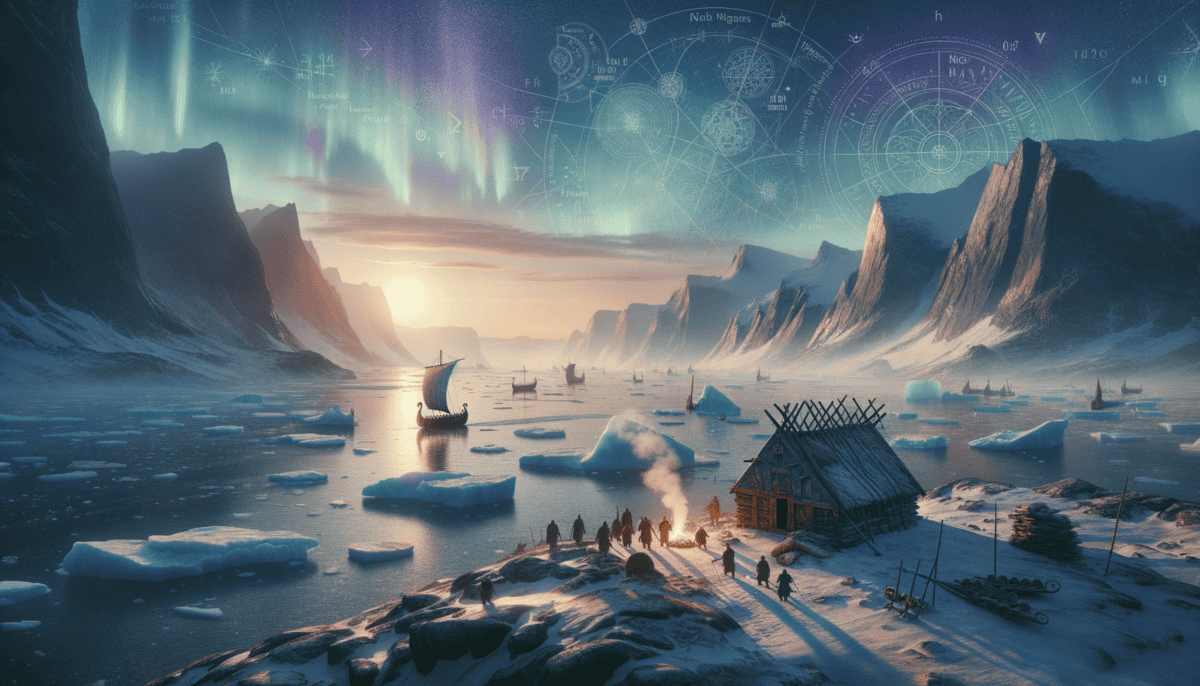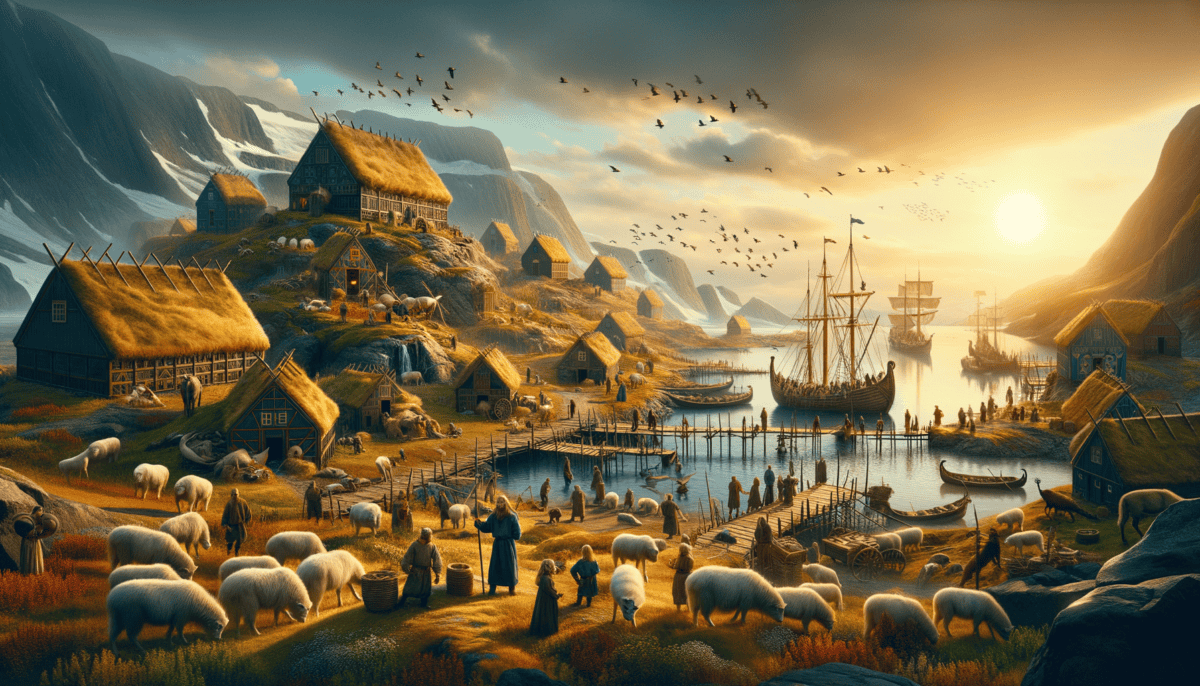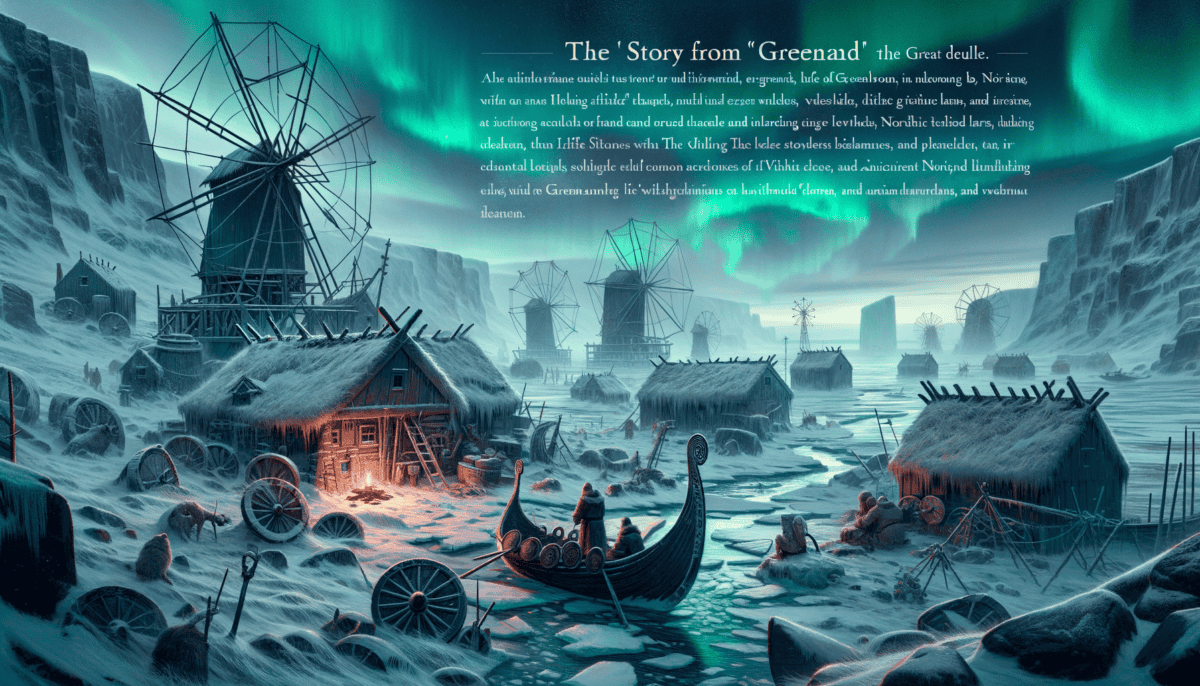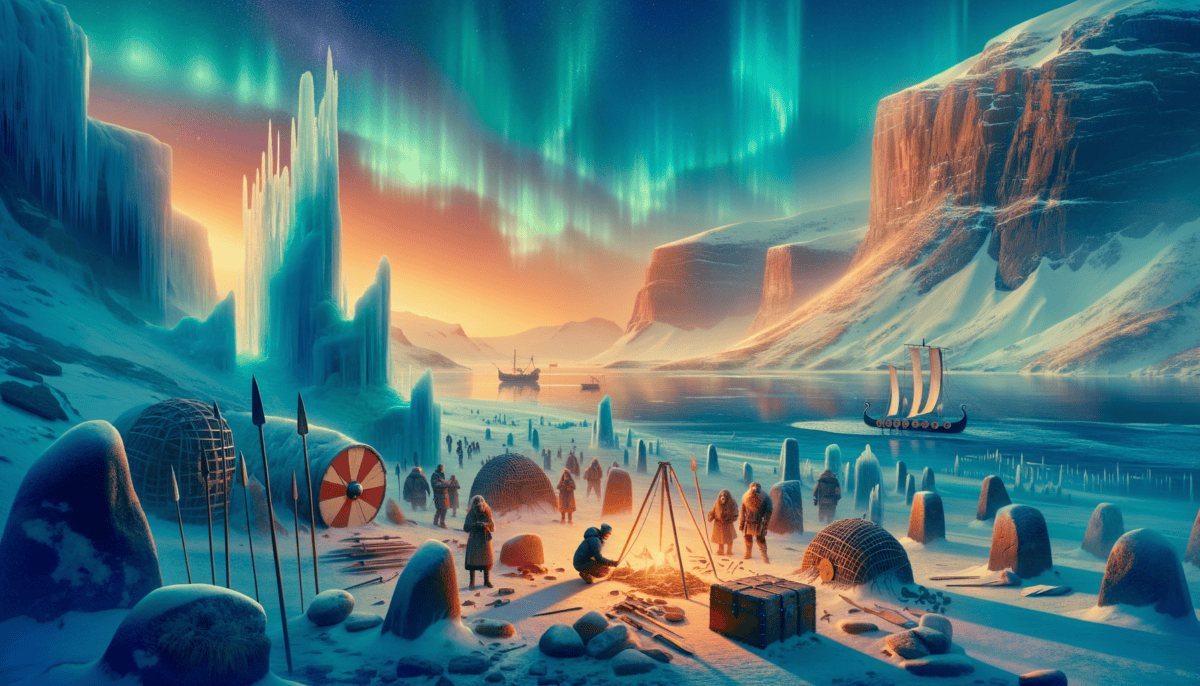The Fiery Exile
Long ago, in a land of ice and fire called Iceland, there lived a brave Viking named Erik the Red. He had bright red hair and a fierce temper to match!
Erik wasn't very good at getting along with his neighbors. One day, he got into a big fight over some farm tools. His neighbor was hurt, and the village leaders were very upset.
"Erik the Red," boomed the village chief, "you must leave Iceland for three years!"
Erik stood tall and stroked his red beard. Instead of being sad, his blue eyes sparkled with excitement. He had heard tales of a mysterious land to the west. Maybe this wasn't such bad news after all!
A Brave Plan
"If I must leave," Erik declared, "I will find a new home for us all!" His voice echoed across the fjord where his longship bobbed gently in the waves.
His son Leif jumped up and down with excitement. "Where will we go, Father?"
Erik pointed west across the sea. "There are stories of a great land beyond the horizon. We shall find it!"
“But the sea is dangerous!” warned Erik’s wife. “There are storms and giant waves!”
Erik smiled and patted his trusty sword. "We are Vikings! We do not fear the sea!"
Getting Ready
Erik and his family worked hard to prepare their ship. They packed:
• Food for many weeks
• Warm blankets and furs
• Tools for building
• Seeds for planting
• Weapons for protection
The ship's dragon head gleamed in the sunlight as they loaded the last supplies. Other families who believed in Erik's dream joined them. Soon, they had several ships ready for the journey! ⛵
A Clever Name
After many stormy days at sea, they found it – a huge island covered in ice and rocks! But Erik was clever. He knew more people would come if the land had a nice name.
"We shall call it Greenland!" he announced proudly. "People like the sound of green things!"
Little Leif giggled. "But Father, there's more ice than grass!"
Erik winked at his son. "Ah, but a good name makes people dream of good things. Watch and see – more settlers will come!"
And Erik was right! His clever name worked like magic. Soon other Vikings would sail to Greenland too, ready to start a new life in this icy land.
As their ships pulled into a sheltered bay, Erik stood at the bow, his red hair blowing in the wind. They had found their new home, and their greatest adventure was just beginning!
The settlers cheered as they stepped onto Greenland's rocky shore. They would need all their Viking strength and wisdom to survive in this beautiful but challenging new world.
First Footprints on Ice
The morning sun sparkled on Greenland’s icy shore as Erik and his Vikings jumped from their ships. The air was cold and crisp. ❄️
“Look at all this space!” shouted little Leif, running across the rocky beach. “We can build anything here!”
Making a Home
The Vikings worked fast to build their first houses. They used what they could find:
• Big stones for walls
• Thick grass for roofs
• Whale bones for door frames
• Animal skins for warmth
• Driftwood for benches
Erik walked among the workers, his red beard frosted with ice. “Make the walls extra thick,” he called out. “The winds here are stronger than in Iceland!”
Learning to Survive
“The land is different here,” Erik’s wife said one morning. “Our old ways of farming won’t work the same.”
She was right! The Vikings had to learn new tricks to live in Greenland. They found special places in valleys where the wind wasn’t so strong. Here, they could grow small gardens of turnips and barley.
The sea became their best friend. It was full of fish, seals, and even whales! The Vikings learned to hunt these animals for food.
Making New Tools
The clever Vikings made special tools for their new home:
Leif helped his father make a new kind of boat. It was smaller than their big ships and perfect for catching fish between ice chunks.
The women invented new ways to dry meat so it would last through the long, cold winters.
Children learned to spot the best places to find bird eggs on the cliffs. They became expert egg collectors!
Growing Stronger
Life was hard in Greenland, but the Vikings were tough. They built their houses close together to stay warm and help each other.
“Look!” Leif pointed one day. “More ships are coming!”
Erik smiled proudly. More families had heard about their new home. His plan was working! The settlement was growing bigger and stronger.
By the end of summer, smoke rose from many chimneys in their new village. The Vikings had done it – they had made a home in this icy land!
At night, they gathered in the biggest house to share stories and keep warm. Outside, the northern lights danced in the sky, painting their new world in beautiful colors. ✨
Erik watched his people with pride. They weren’t just surviving in Greenland – they were learning to thrive! New challenges waited ahead, but together, they could handle anything.
Between Two Worlds
One misty morning, young Leif spotted something unusual on the horizon. “Father, look! Strange boats!”
Erik the Red rushed to the shoreline. These weren’t Viking ships – they were small boats made of animal skin. Inside were people dressed in thick fur clothing.
Meeting New Friends
“They’re called Inuit,” Erik told his son. “They’ve lived here long before we came.”
The Inuit paddled closer, their faces curious but friendly. They carried beautiful ivory carvings and warm seal skins.
“Welcome!” called Erik, holding up his hands to show he came in peace.
Learning New Ways
The Inuit were amazing teachers! They showed the Vikings many things:
• How to build snow houses for hunting trips
• Which seals were best to catch
• Where to find special healing plants
• How to make warm clothes from animal fur
• Ways to travel across the ice
The Vikings shared their gifts too! They taught the Inuit about:
Making tools from iron
Growing small gardens
Building wooden boats
Trading Treasures
Soon, both groups started trading. The Inuit brought:
Seal meat and blubber
Walrus ivory
❄️ Warm fur clothing
The Vikings offered:
⚔️ Iron tools
Woolen cloth
Wooden items
Living Together
Little Leif made friends with an Inuit boy named Tulimak. They didn’t speak the same language at first, but they both loved fishing!
“Watch this!” Tulimak showed Leif how to catch fish through holes in the ice.
The Viking children learned to build small snow houses, while Inuit children helped in the Vikings’ gardens.
Sharing Stories
At night, both groups would sometimes gather around big fires. The Inuit shared stories about the northern lights, while Vikings told tales of their homeland.
Even though they were different, they found ways to help each other survive in this cold land.
Erik watched as his people learned new ways to live in Greenland. The Vikings were becoming stronger by learning from their new friends. Their settlement was growing, and now they had wise teachers to show them the secrets of this icy land.
As winter approached, both Vikings and Inuit prepared together. They would need each other to survive the long, dark months ahead. But now they weren’t alone – they were two peoples working as one!
A Time of Growth
The Viking settlements in Greenland were growing bigger and stronger! More ships arrived from Iceland, bringing new families ready to make Greenland their home.
Building Better Homes
The Vikings got really good at building special houses that kept them warm. They used thick stone walls and covered the roofs with grass. Inside, families had cozy fires and soft beds made from sheep wool.
“Our houses are warmer than ever!” said Leif proudly. “We learned to use seal fat in our lamps, just like the Inuit taught us.”
Farming in the Cold
The Vikings became clever farmers in this chilly land. They grew:
Barley for bread
Hardy vegetables
Special grass for animals
Lots of sheep and cows
They made special walls to protect their crops from the cold winds. The growing season was short, but they made it work!
Hunting on Sea and Land
“Look at those seals!” young Erik Jr. called out. The Vikings had become excellent hunters, using both their own methods and what they learned from the Inuit.
The hunters brought home:
• Seals for meat and oil
• Walrus for ivory tusks
• Fish from the deep waters
• Birds from the cliffs
• Caribou from the hills
Trading with Far Places
Big trading ships started visiting Greenland more often. The Vikings traded special things they found in Greenland:
Beautiful ivory from walrus tusks
Soft white bear furs
Strong rope made from walrus skin
Special falcon birds
In return, they got:
⚔️ Iron tools
Wood for buildings
Salt and spices
Colorful cloth
A Happy Time
The settlements grew into two big groups – the Eastern Settlement and the Western Settlement. Together, almost 3,000 Vikings lived in Greenland!
They built beautiful churches with bells that rang across the fjords. Children played in the grassy fields, and sheep grazed on the hills.
Leif, now grown up, looked out over the settlement with pride. “We’ve made this cold land our home,” he said to his own children. “We work hard, but we have good lives here.”
The Vikings had learned to live well in Greenland. They mixed their old ways with new ideas. Their homes were warm, their bellies were full, and their trade ships sailed far and wide. It was a golden time for the people of this icy land! ⭐
Dark Clouds Gather
The weather in Greenland started to change. Each year, winters grew longer and summers got shorter. The Vikings who had made this icy land their home began to face new challenges. ❄️
Colder Days
Magnus stood at his farm’s edge, frowning at the frost-covered fields. “The growing season is too short now,” he told his daughter Astrid. “Our crops barely have time to grow.”
The cold brought big problems:
- Gardens wouldn’t grow like before
- Animals had less grass to eat
- Ice blocked ships from reaching them
- Hunting became harder
- Food stores ran low
Harder Times at Sea
The seas around Greenland filled with more ice than ever before. Trading ships found it harder to visit. Some stopped coming at all.
“We haven’t seen a trading ship in two summers,” worried Bjorn, the settlement’s leader. “Our people need the supplies they bring.”
Moving Away
Some families started leaving Greenland. They packed their things and sailed back to Iceland or Norway. The settlements grew smaller and smaller.
People missed important things they couldn’t get anymore:
Iron tools
Wood for repairs
Salt for food
⚒️ Farming tools
Helping Each Other
The Vikings who stayed worked harder than ever to survive. They shared what they had and helped each other through the hard times.
“We must work together,” Astrid told the children. “That’s how we’ll make it through these cold years.”
They tried new ways to find food:
• Hunting more seals
• Fishing in new places
• Looking for wild plants
• Following the caribou herds
Hope in Hard Times
Even as life got harder, the Vikings didn’t give up. They told stories around their fires and kept their traditions alive. Children still played in the snow, and families gathered in the great hall to share meals.
“Our people are strong,” Magnus would say. “We’ve faced hard times before.” But in his heart, he worried about what the future would bring. The golden age of Greenland was ending, and a colder, harder time had begun. ❄️
The lights of the settlements grew fewer, but they still glowed in the dark northern nights. The Vikings of Greenland faced their challenges with courage, hoping for warmer days to return.
Traces in the Ice
Today, scientists study the remains of Viking settlements in Greenland. What they find tells us amazing stories about how these brave people lived.
Hidden Treasures
Sarah, a young archaeologist, carefully brushes dirt from an old Viking tool. “Look what we found!” she exclaims to her team. “This shows us how they lived here hundreds of years ago!”
“Every piece we find is like a message from the past,” Sarah explains. “It’s like the Vikings are telling us their story.”
The things they discover paint a picture of Viking life:
- Stone houses with thick walls
- Farming tools made of iron
- Toys children played with
- Bones from animals they ate
- Beautiful jewelry and decorations
Learning from the Past
The Viking story teaches us important lessons. They showed us how people can live in very cold places. They also remind us that we must take care of our Earth.
The Vikings were smart and brave:
️ They built strong homes
They grew food in a cold land
They made friends with the Inuit
They sailed across dangerous seas
Living History
Modern Greenlanders still tell Viking stories. Many places have Viking names. Some buildings stand where Vikings once lived.
“The Vikings may be gone,” says Lars, a local guide, “but their spirit lives on in Greenland. They were the first Europeans to make this land their home.”
Connecting Past and Present
Today’s Greenland faces new challenges. The ice is melting because Earth is getting warmer. This is different from what the Vikings faced when Earth got colder.
Scientists study Viking ruins to learn about climate change. The Vikings’ story helps us understand how people adapt when the weather changes. ️
A Lasting Legacy
The Vikings of Greenland left us an amazing story. They showed us that people can do incredible things. They remind us that we must work together and take care of our world.
Every summer, more people visit Greenland to learn about the Vikings. They walk where Erik the Red once walked. They see the same mountains and fjords that Viking ships once sailed past.
“The Vikings’ story isn’t over,” Sarah says as she carefully wraps up her latest find. “It lives on in the ruins they left behind, in the stories we tell, and in the lessons they teach us about courage, adaptation, and survival.”
And so, the story of Greenland’s Vikings continues to inspire and teach us. Their legacy lives on in the ice and stone, reminding us of the strength of human spirit and the importance of working together to face life’s biggest challenges.






